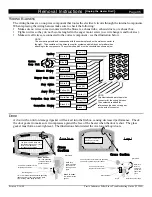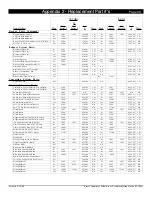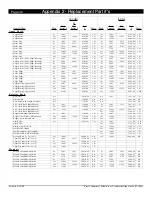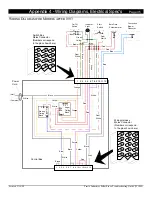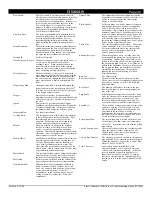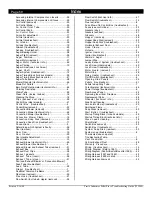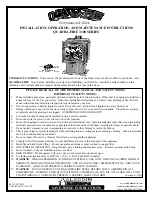
Glossary
Page 49
Printed 3/18/98
Travis Industries Pellet Stove Troubleshooting Guide (
1994)
Flow Switch:
The flow switch is a pressure-sensitive device
which detects if the exhaust fan quits or if the flue
becomes blocked. It is an aluminum cylinder
located in the rear of the appliance. It connects to
two wires and one rubber tube that goes to the
flow switch nipple. It is required for safety
purposes. Because of its sensitivity, it may need to
be adjusted for high altitude installations (call
Travis for more information).
Front Leg Bolts:
The front leg attachment bolts penetrate into the
firebox on pellet stoves. Because these bolts are
not used for pedestal installations, it is very
important that the installer replace these bolts
when installing the pedestal to eliminate an air
leak.
Hearth Extension:
The hearth extension is the non-combustible area
extending beyond the face of the fireplace insert.
When installing a pellet insert, make sure the
hearth extension is long enough to accommodate
the space the insert extends into the room.
Hearth Pad:
See 'Floor Protection'.
Heat Exchanger Scraper: The heat exchanger scraper (also called 'rake') is
a steel piece with holes for each of heat
exchanger tubes. When the handle above the
door is moved back and forth (make sure the
doors are closed) the flyash is removed from the
tubes, increasing heating efficiency.
Heat Exchanger:
The heat exchanger is the set of 12 horizontal
pipes running along the top of the firebox with the
ends exiting into the room. Air is pumped from
the convection fan, through the heat exchanger
pipes where the air is heated, and then into the
room.
Hopper Snap Disk:
The hopper snap disk is located underneath the
hopper and senses any temperatures above 200
o
.
It is used as a safety feature to shut off the auger
if the hopper becomes too hot.
Hopper:
Storage area for pellets. Designed to hold
maximum amount of pellets for space allowed and
still feed every pellet. Located on the top rear of
the stove.
Igniter:
The igniter is a cylindrical heating element
positioned directly behind the firepot. During the
15 minute startup period it heats the air entering
the burnpot which causes the pellets to ignite.
Inspection Plate:
See 'Rear Access Panel'.
Leveling Bolts:
The leveling bolts are used for insert installations
to level the appliance inside the fireplace. They
insert through press nuts at the rear of the
baseplate. Many fireplaces have stepped up
hearths, making leveling bolts necessary.
Mantle:
Fireplace mantles are designed for aesthetic
reasons. Because it is directly above a heat
source, it can become extremely hot during
operation. Combustible mantles must meet certain
clearances. Non-combustible mantles are exempt
from clearances for pellet stoves.
Mobile Home:
Mobile home installations require certain items not
required in normal residences because they are
air-tight. The appliance must be installed as a
stove with a permanent outside air inlet. The
stove must also be grounded to the chassis of the
mobile home. And in certain states, the stove must
be permanently bolted to the floor.
Motor Guard:
The steel grate which extends below the baseplate
on pellet inserts. It can be removed to facilitate
the removal of the auger motor and auger flight.
Motor Stop:
The motor stop is attached near the bottom of the
auger and keeps the auger motor from spinning.
Non-combustible:
Materials that will not ignite when subjected to
flame for extensive time. Includes steel, iron,
brick, tile, concrete, slate, asbestos, glass, plaster,
or any combination thereof. If there is
uncertainty as to the construction of a wall or
ceiling, assume it is combustible. Drywall is
combustible.
Output Shaft:
The output shaft is the shaft extending from the
auger motor that connects to the drive collar. It is
geared to the auger motor and transfers the
energy to the auger flight.
Pellet Quality:
Pellets are made of wood by-products (sawdust),
making them inexpensive and environmentally
correct. Because they burn in a controlled
environment, they are much less polluting for the
amount of heat given off. Pellet quality varies in
terms of moisture content, ash, purity (dirt or salt),
length, and diameter (7 mm or 1/4"). There are
no monitoring agencies to control pellet quality,
therefore the consumer should test a bag of pellets
before buying a significant amount.
Pellet Vent:
The venting system for pellet stoves. The system
can be horizontal (direct) or vertical for stoves.
For inserts and hearth stoves the venting can be
positive, direct, or horizontal. Refer to the
owner's manual for details.
Priming the Auger:
When the appliance is new, or if the stove has
been run until the pellets run out, the auger will
need priming. It takes about ten minutes for the
pellets to travel from the base of the auger tube to
the burnpot (on high feed rate). So if there are no
pellets in the auger tube, the auger will need to be
run on high for about ten minutes before pellets
start falling into the burnpot. This process of
running the stove before lighting it is called
'Priming the Auger'.
Rain Cap:
See 'Chimney Cap'.
Rear Access Panel"
The panel at the rear of the pellet stove which
allows access to several components including the
auger motor, and flow switch. Also called the
Inspection Plate'.
Rear Panel:
The panel on pellet stoves located on the rear.
Remove this panel to access components at the
rear of the stove.
Snap Disks:
Pellet appliances contain three snap disks. Snap
disks are electronic devices that sense when the
temperature rises above a certain level. The
three snap disks are the hopper snap disk, the
convection snap disk, and the system snap disk.
Switch Box:
The switch box contains the controls for the pellet
appliance. Coming off of the switch box is an
electrical cord that connects to the control box.
Contained in the switch box is wiring, a
potentiometer for feed rate, a potentiometer for
the convection fan, an on/off switch, and a start
switch (momentary rocker switch).
System Snap Disk:
The system snap disk is located on the back side
of the exhaust box and senses any temperatures
above 120
o
. It turns the stove off once the pellets
stop burning.
Vertical Exhaust Vent:
The vertical exhaust vent is the vent that extends
along the right rear corner of the insert. It is
clipped in and can be removed to facilitate a
horizontal venting scheme.
Vertical Pipe Adapter:
The vertical pipe adapter attaches to the exhaust
pipe and allows for a centered pellet vent directly
behind the appliance. Also called a 'Center Flue
Adapter'. Part # 99300138.
Zero-Clearance:
Pellet inserts can be installed into a zero-
clearance fireplace or as a built-in unit (often
called a zero-clearance installation). When the
insert is installed as a built-in unit the Travis
Industries floor shield is required. It is placed
directly on the floor and the surrounding wall is
framed up to it. See the owner's manual for full
details.
Содержание 400 PI
Страница 46: ......

